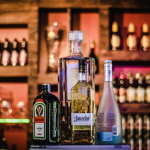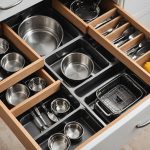Importance of Bar Layout Optimization
Optimizing bar layout is crucial for enhancing customer experience and boosting event efficiency. The arrangement of service points significantly impacts the flow of customers and the speed of service. A well-thought-out layout minimizes wait times, ensuring guests receive prompt and attentive service. By streamlining pathways and access points, bars can accommodate more patrons comfortably, enhancing their overall experience.
Efficient layouts contribute to event success by balancing aesthetics with functionality. While a bar must be visually appealing, its practicality must not be compromised. Aesthetic elements should complement a design that supports seamless operations, such as clear signage and an intuitive customer flow. This balance fosters an inviting atmosphere, encouraging guests to linger and enjoy their time without frustrating interruptions.
Also read : Essential Gadgets and Appliances for a Health-Focused Raw Food Restaurant Kitchen
Moreover, optimizing the layout directly influences staff efficiency. Employees can perform tasks more swiftly when their workspace is arranged to minimize unnecessary movement. Consequently, optimized bars yield higher turnover and satisfaction rates, crucial metrics for a successful customer experience.
Assessing Current Bar Configuration
Evaluating the existing setup of a bar is crucial for optimizing layout. By conducting a thorough layout assessment, businesses can identify areas needing improvement. The first step is to analyze current customer traffic patterns. This involves observing how clients move through the space, pinpointing paths of frequent congestion, and noting any bottlenecks that impede flow.
In the same genre : Why You Should Buy Craft Alcohol Made in America for Your Home Bar
Gathering feedback from staff is another valuable strategy in bar space evaluation. Employees can offer insights into layout issues they encounter during shifts, such as tight workspaces or awkward storage placements. These frontline perspectives are essential for understanding practical day-to-day challenges.
Identifying inefficient areas allows management to implement targeted improvements. For example, rearranging high-demand service points closer to entrances can improve accessibility. Additionally, reallocating underutilized sections for customer seating can enhance the overall atmosphere.
Ultimately, a comprehensive assessment of the current bar configuration helps identify deficiencies that may impact efficiency and customer experience. By addressing these concerns, businesses are poised to create a more efficient and inviting environment.
Practical Design Strategies for Bar Layout
Implementing efficient bar design tactics is essential for optimizing space and enhancing operations. One key approach is utilizing zoning techniques to create distinct service areas. This method involves strategically dividing the bar into sections — such as the ordering zone, seating, and high-traffic pathways — to smooth customer and staff flow.
Ensuring optimal space optimization also requires careful attention to bar dimensions. Bars should be designed with sufficient width to accommodate movement behind the counter and around seating areas to prevent congestion at peak times. Recommended dimensions often depend on the anticipated customer volume, with a wider bar surface allowing for multiple service points.
The effective use of vertical space through shelving solutions can significantly improve storage without sacrificing floor area. Vertical shelves can be perfect for displaying bottles or organizing glassware, making valuable items easily accessible and visible to staff, thus enhancing the operational workflow.
Incorporating these bar design tactics helps maximize efficiency and improve the overall guest experience in any event setting. By thoughtfully considering zoning, dimensions, and shelving, bars can operate smoothly even during their busiest periods.
Workflow Enhancements for Increased Efficiency
Enhancing the operational workflow in bars is vital for bolstering staff efficiency and accelerating service speed. Streamlining staff movement through well-considered layout changes can drastically improve performance. For instance, positioning high-demand service stations within easy reach reduces unnecessary steps, allowing staff to serve customers more swiftly.
Incorporating technology plays a pivotal role in optimizing service speed. The use of point-of-sale systems and automated drink dispensers can significantly expedite orders and transactions. This technological integration not only quickens service but also minimizes errors and enhances accuracy.
Additionally, best practices for inventory placement contribute to a seamless operational workflow. Inventory should be organized logically, with frequently used items within immediate reach and less-used supplies stored efficiently. This arrangement prevents delays in service during busy periods and ensures that staff can maintain a rapid pace without disruption.
By focusing on these strategies, bars can foster a productive work environment that supports quick and efficient service, ultimately improving the overall guest experience and boosting event success.
Managing Crowd Flow During Events
Effectively managing crowd flow during events is crucial for enhancing the overall customer navigation experience and ensuring smooth engagement strategies. A well-orchestrated entry-to-service area flow is essential. Guests should encounter clear signage and branding to help them navigate efficiently. Strategic sign placement can significantly ease entry and reduce congestion, directing crowds smoothly toward their intended destinations.
Employing practical case studies can reveal successful crowd management tactics applicable to a variety of settings. For instance, some venues have streamlined flow by creating dedicated paths for distinct activities, such as separate lines for drink orders and food pickups. Such implementations minimize cross-traffic and maintain a steady flow, enhancing the guest experience.
Logic in layout doesn’t just end with signposting but involves a thought-out design where entry points and exits are well-defined and accessible. These strategies are bolstered by real-world examples, showing that thoughtful planning can transform the event atmosphere, making it enjoyable and less stressful for both attendees and staff. This holistic approach ensures both functionality and customer satisfaction are prioritized, reinforcing the importance of effective customer navigation.
Space-Saving Techniques for Bars
Effective bar layout design hinges on space efficiency, which can transform any venue into a versatile environment. Compact bar solutions are vital, particularly in settings where space is at a premium. Innovative furniture choices, like stackable stools and foldable tables, can maximize usable area without sacrificing event efficiency. These options make reconfiguring the space for different events seamless, enhancing customer experience by maintaining an open, inviting atmosphere.
Modular furniture introduces a flexibility in design that allows for rapid adjustments in layout — perfect for adapting to varying crowd sizes or event themes. Furniture pieces that can be easily rearranged offer a dynamic approach to bar layout design, ensuring that both staff and guests can navigate the space comfortably.
Utilizing outdoor spaces, especially during peak hours, adds an extra dimension to layout design. By creatively incorporating terraces or patios, bars not only expand their service areas but also provide an attractive alternative for customers looking to enjoy the ambience. Ensuring that these spaces are as functional as the interior further elevates the customer experience, making the bar more versatile and accommodating for any event.
Successful Bar Setup Examples
Examining real-life examples of effective bar layouts offers valuable insights into successful bar layout design. These detailed event case studies demonstrate how innovative strategies have enhanced event efficiency and customer experience.
For instance, a popular city bar transformed its cramped setup by utilizing compact bar solutions. By incorporating modular furniture, such as adaptable counters and flexible seating arrangements, the venue improved space utilization. Resulting in easier navigation for both staff and guests, ultimately boosting service speed during peak hours.
Before-and-after comparisons highlight the dramatic effects of strategic redesign. One bar example focused on enhancing customer flow, adding clear pathways and distinct service zones, improving overall customer satisfaction. This strategic layout encouraged guests to explore different event sections seamlessly.
Key takeaways from these implementations emphasize the importance of balancing aesthetics with functionality. By prioritizing flexibility in design while maintaining an inviting atmosphere, bars can cater to varying crowd sizes and event themes. Visual illustrations from various successful setups can serve as a design inspiration, prompting bars to reimagine their spaces and potential for improved performance.





